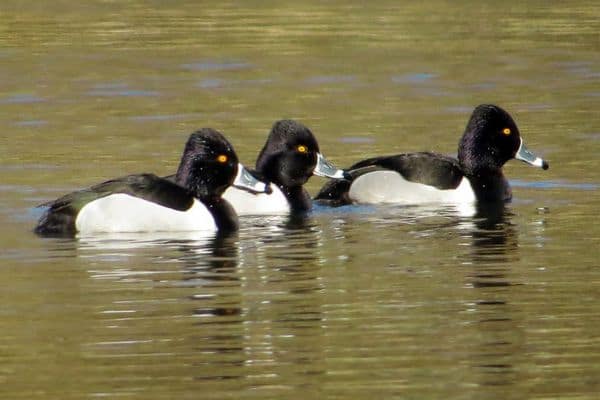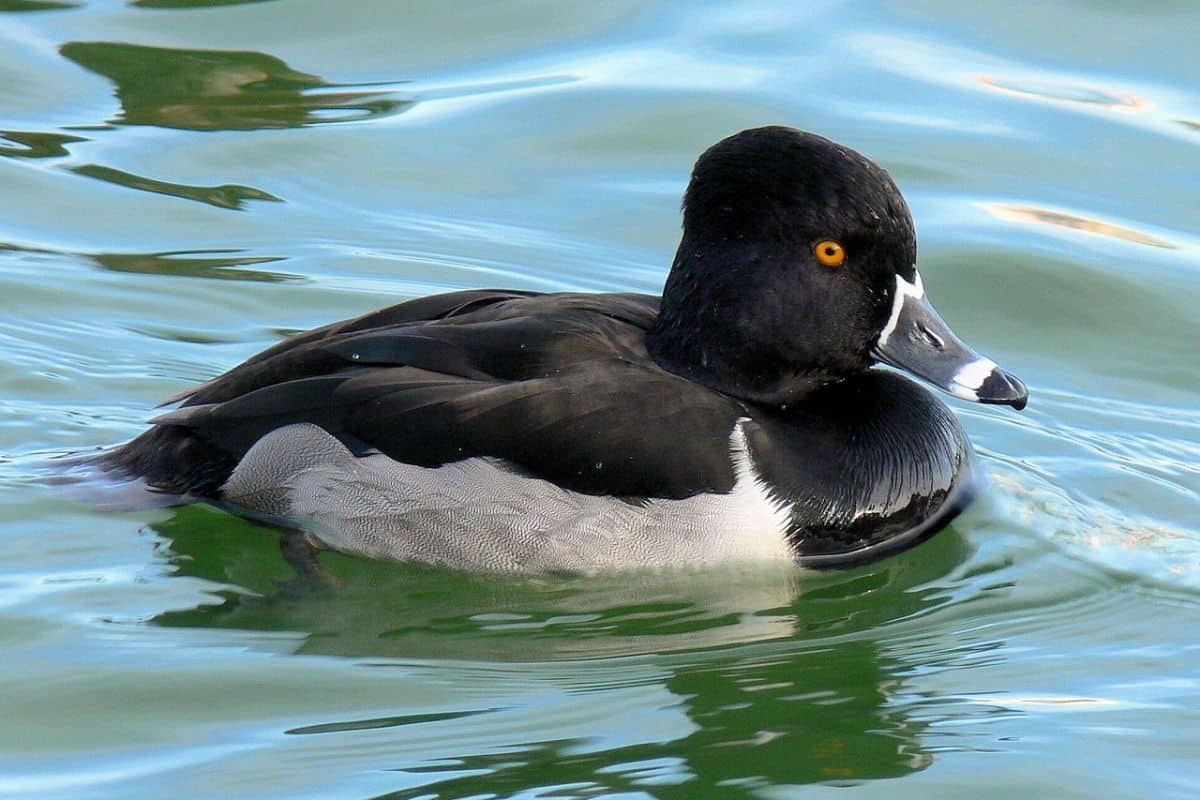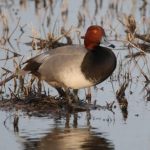Common Name: Ring-necked Duck
Scientific Name: Aythya collaris| Size | Diet | Range in Hawaii | Status in Hawaii |
|---|---|---|---|
| 14 in. - 17 in. | insects, crustaceans, mollusks, and small fish | Oahu, Maui, and the Big Island | Least Concern |
The Ring-necked Duck, also known as Aythya collaris, is a medium-sized diving duck that is native to North America. With its striking black and white plumage and distinctive ring around its neck, the Ring-necked Duck is a beautiful and fascinating bird to observe. While it is most commonly found in northern regions, it has also been known to visit more southern areas during the winter months.
Interestingly, the Ring-necked Duck has also been spotted in Hawaii, where it is considered a rare visitor. In this article, we’ll explore the world of the Ring-necked Duck and learn more about its existence in Hawaii.
Ring-necked Duck
Appearance

The Ring-necked Duck is a medium-sized diving duck known for its distinctive appearance. Adult males have a glossy black head and neck, with a white vertical mark on the side of the bill. They have a gray body, black back, and a white crescent-shaped patch on the sides.
Females and juveniles have a brownish overall plumage with a lighter face and a dark eye patch. Both males and females have a bluish-gray bill. In terms of size, Ring-necked Ducks typically measure around 14 to 17 inches (35 to 43 cm) in length.
Diet
The Ring-necked Duck has a diverse diet that primarily consists of aquatic invertebrates. They feed on a variety of small aquatic creatures such as insects, crustaceans, mollusks, and small fish.
These ducks are skilled divers, capable of submerging themselves underwater to search for food. They use their specialized bills to filter out and capture prey from the water.
Additionally, Ring-necked Ducks also consume plant matter, including seeds and vegetation found in and around their aquatic habitats. Their flexible feeding habits allow them to adapt to the availability of different food sources throughout the year.
Nesting
The Ring-necked Duck nests in a variety of wetland habitats, including marshes, ponds, and lakes with dense vegetation. They typically build their nests on the ground, hidden among tall grasses or in vegetation near the water’s edge.
The female constructs the nest using plant materials such as grasses, twigs, and down feathers, lining it with softer materials for added comfort. She lays a clutch of 6 to 10 eggs, which are creamy white or pale green in color.
The female incubates the eggs for about 25 to 29 days, diligently keeping them warm and protected. After hatching, the precocial ducklings leave the nest and quickly make their way to the water, guided by their mother. They become independent and capable of feeding themselves shortly after hatching, although the female continues to provide protection and guidance.
Behavior

The Ring-necked Duck exhibits interesting behaviors that are characteristic of diving ducks. They are highly skilled divers, capable of staying submerged for extended periods in search of food.
Their dives can be sudden and swift, disappearing beneath the water’s surface with a quick flick of their wings. Ring-necked Ducks are social birds and often form small to large flocks, particularly during migration and wintering periods.
Within these flocks, they engage in synchronized swimming and coordinated foraging, which can enhance their feeding efficiency and provide protection against predators. During the breeding season, males perform courtship displays to attract females. These displays involve head-throws, wing-flapping, and low calls.
Once pairs are formed, they exhibit monogamous behavior throughout the breeding season. Ring-necked Ducks are generally shy and cautious, often taking flight when approached too closely.
When alarmed, they quickly take off from the water with a characteristic whistling sound produced by their wings. In addition to their diving abilities, Ring-necked Ducks are also capable of flying swiftly and agilely, with rapid wingbeats.
They migrate between their breeding and wintering grounds, traveling long distances to find suitable habitats and food sources. These ducks are primarily active during the day, feeding and resting during daylight hours. They rely on their keen eyesight and sharp senses to locate and assess potential threats in their surroundings.
Habitat
The Ring-necked Duck is a species that thrives in a variety of wetland habitats across North America. They can be found in freshwater environments such as marshes, ponds, lakes, and reservoirs. Ring-necked Ducks prefer habitats with dense emergent vegetation, such as cattails and bulrushes, which provide cover for nesting and protection from predators.
During the breeding season, they inhabit boreal forest wetlands and smaller, secluded bodies of water. In winter, they migrate to more open water habitats, including coastal bays, estuaries, and larger lakes. They are often seen in areas with abundant aquatic vegetation and submerged plants, as these serve as important food sources.
Ring-necked Ducks are adaptable and can tolerate a range of water conditions, from acidic to alkaline, and from clear to turbid. However, they generally prefer habitats with calm or slow-moving waters, avoiding areas with strong currents.
Their extensive distribution allows them to utilize various wetland habitats throughout their annual cycle, from breeding to migration and wintering. Their ability to adapt to different wetland environments contributes to their resilience and survival as a species.
Range
According to Hawaii Birding Tours, the Ring-necked Duck is a rare visitor to Hawaii, but has been spotted on several of the islands, including Oahu, Maui, and the Big Island. While sightings are infrequent and unpredictable, the bird has been observed in these locations during the winter months. Despite its rarity in Hawaii, the Ring-necked Duck is known to be a common species in other parts of North America.
Conservation Status

The Ring-necked Duck is currently categorized as a species of least concern on the IUCN Red List of Threatened Species. While their population size and overall range appear to be stable, it is important to monitor their status and address potential threats to their habitats.
Interesting Facts
1. Unique Name
The Ring-necked Duck gets its name from a faint chestnut-colored ring on its neck, which is often difficult to see unless observed at close range.
2. Misleading Ring
Despite their name, the distinctive ring on the neck of the male Ring-necked Duck is often not visible, as it can be hidden by the bird’s feathers.
3. Social Flocks
Ring-necked Ducks are often seen in flocks during migration and wintering periods, sometimes gathering in large groups numbering in the thousands.
4. Vocalization
The male Ring-necked Duck produces a variety of vocalizations, including soft whistles, grunts, and growls, which are used for communication and courtship.
5. Camouflaged Plumage
The mottled brown plumage of the female Ring-necked Duck provides excellent camouflage, helping her blend into her surroundings and protect her from predators.
Frequently Asked Questions
1. What is the average lifespan of Ring-necked Ducks?
Ring-necked Ducks have been known to live up to 13 years in the wild, although the average lifespan is typically shorter.
2. Do Ring-necked Ducks migrate?
Yes, Ring-necked Ducks are migratory birds. They undertake long-distance migrations between their breeding and wintering grounds.
3. Do Ring-necked Ducks have any predators?
Common predators of Ring-necked Ducks include larger birds of prey, such as eagles and hawks, as well as some mammalian predators like raccoons and foxes.




